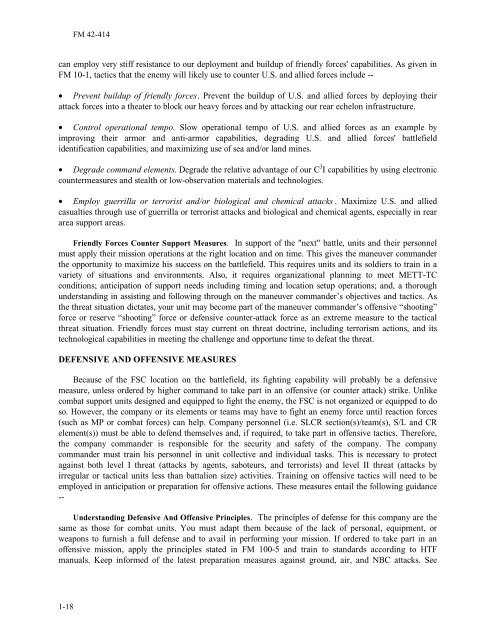Tactics, techniques, and procedures for - Army Electronic ...
Tactics, techniques, and procedures for - Army Electronic ...
Tactics, techniques, and procedures for - Army Electronic ...
Create successful ePaper yourself
Turn your PDF publications into a flip-book with our unique Google optimized e-Paper software.
1-18<br />
FM 42-414<br />
can employ very stiff resistance to our deployment <strong>and</strong> buildup of friendly <strong>for</strong>ces' capabilities. As given in<br />
FM 10-1, tactics that the enemy will likely use to counter U.S. <strong>and</strong> allied <strong>for</strong>ces include --<br />
• Prevent buildup of friendly <strong>for</strong>ces. Prevent the buildup of U.S. <strong>and</strong> allied <strong>for</strong>ces by deploying their<br />
attack <strong>for</strong>ces into a theater to block our heavy <strong>for</strong>ces <strong>and</strong> by attacking our rear echelon infrastructure.<br />
• Control operational tempo. Slow operational tempo of U.S. <strong>and</strong> allied <strong>for</strong>ces as an example by<br />
improving their armor <strong>and</strong> anti-armor capabilities, degrading U.S. <strong>and</strong> allied <strong>for</strong>ces' battlefield<br />
identification capabilities, <strong>and</strong> maximizing use of sea <strong>and</strong>/or l<strong>and</strong> mines.<br />
• Degrade comm<strong>and</strong> elements. Degrade the relative advantage of our C 3 I capabilities by using electronic<br />
countermeasures <strong>and</strong> stealth or low-observation materials <strong>and</strong> technologies.<br />
• Employ guerrilla or terrorist <strong>and</strong>/or biological <strong>and</strong> chemical attacks . Maximize U.S. <strong>and</strong> allied<br />
casualties through use of guerrilla or terrorist attacks <strong>and</strong> biological <strong>and</strong> chemical agents, especially in rear<br />
area support areas.<br />
Friendly Forces Counter Support Measures. In support of the "next" battle, units <strong>and</strong> their personnel<br />
must apply their mission operations at the right location <strong>and</strong> on time. This gives the maneuver comm<strong>and</strong>er<br />
the opportunity to maximize his success on the battlefield. This requires units <strong>and</strong> its soldiers to train in a<br />
variety of situations <strong>and</strong> environments. Also, it requires organizational planning to meet METT-TC<br />
conditions; anticipation of support needs including timing <strong>and</strong> location setup operations; <strong>and</strong>, a thorough<br />
underst<strong>and</strong>ing in assisting <strong>and</strong> following through on the maneuver comm<strong>and</strong>er’s objectives <strong>and</strong> tactics. As<br />
the threat situation dictates, your unit may become part of the maneuver comm<strong>and</strong>er’s offensive “shooting”<br />
<strong>for</strong>ce or reserve “shooting” <strong>for</strong>ce or defensive counter-attack <strong>for</strong>ce as an extreme measure to the tactical<br />
threat situation. Friendly <strong>for</strong>ces must stay current on threat doctrine, including terrorism actions, <strong>and</strong> its<br />
technological capabilities in meeting the challenge <strong>and</strong> opportune time to defeat the threat.<br />
DEFENSIVE AND OFFENSIVE MEASURES<br />
Because of the FSC location on the battlefield, its fighting capability will probably be a defensive<br />
measure, unless ordered by higher comm<strong>and</strong> to take part in an offensive (or counter attack) strike. Unlike<br />
combat support units designed <strong>and</strong> equipped to fight the enemy, the FSC is not organized or equipped to do<br />
so. However, the company or its elements or teams may have to fight an enemy <strong>for</strong>ce until reaction <strong>for</strong>ces<br />
(such as MP or combat <strong>for</strong>ces) can help. Company personnel (i.e. SLCR section(s)/team(s), S/L <strong>and</strong> CR<br />
element(s)) must be able to defend themselves <strong>and</strong>, if required, to take part in offensive tactics. There<strong>for</strong>e,<br />
the company comm<strong>and</strong>er is responsible <strong>for</strong> the security <strong>and</strong> safety of the company. The company<br />
comm<strong>and</strong>er must train his personnel in unit collective <strong>and</strong> individual tasks. This is necessary to protect<br />
against both level I threat (attacks by agents, saboteurs, <strong>and</strong> terrorists) <strong>and</strong> level II threat (attacks by<br />
irregular or tactical units less than battalion size) activities. Training on offensive tactics will need to be<br />
employed in anticipation or preparation <strong>for</strong> offensive actions. These measures entail the following guidance<br />
--<br />
Underst<strong>and</strong>ing Defensive And Offensive Principles. The principles of defense <strong>for</strong> this company are the<br />
same as those <strong>for</strong> combat units. You must adapt them because of the lack of personal, equipment, or<br />
weapons to furnish a full defense <strong>and</strong> to avail in per<strong>for</strong>ming your mission. If ordered to take part in an<br />
offensive mission, apply the principles stated in FM 100-5 <strong>and</strong> train to st<strong>and</strong>ards according to HTF<br />
manuals. Keep in<strong>for</strong>med of the latest preparation measures against ground, air, <strong>and</strong> NBC attacks. See

















